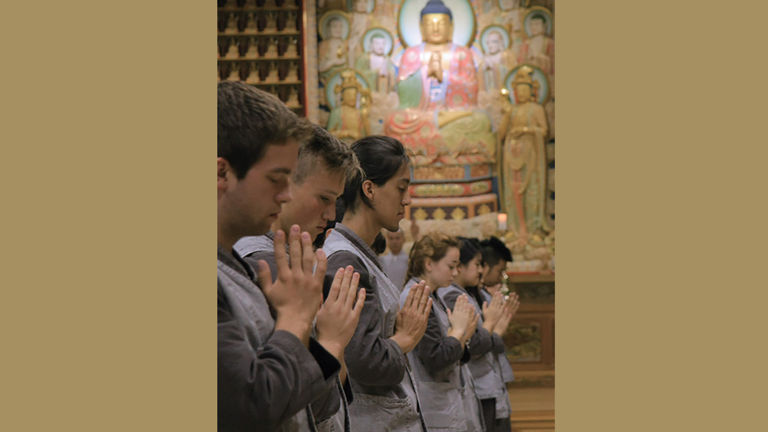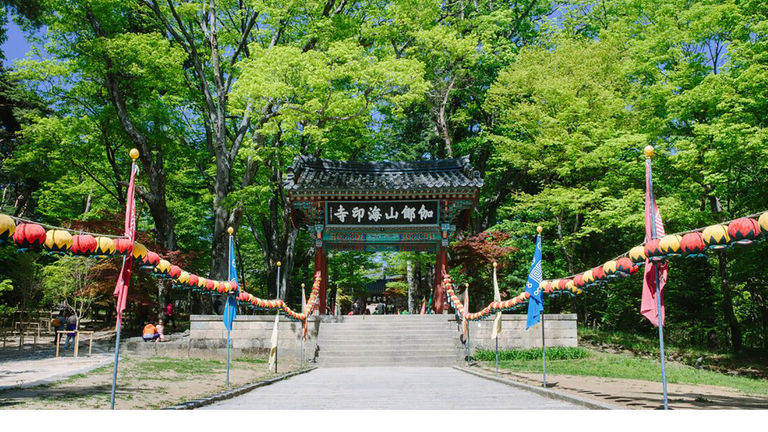From any angle you look at it, South Korea is having a moment. Whether you’ve got a K-pop beat swirling in your head, or you’re obsessing over a new Korean drama, chances are good that your (or your client’s) interest in the destination is piqued, and probably more so than it ever was. And the country may manage to capitalize on international interest with Visit Korea Year, a campaign running through 2024 that aims to entice travelers to explore the country’s rich history and culture.
Should clients inquire about Korea, city tours of Seoul and Busan are surely top-of-mind, and perhaps gems such as Jeju Island and Gyeongju, as well. But how should travelers dig into each destination, and what specific sights should they see?
Esther Cho, marketing coordinator for the Korea Tourism Organization (KTO), suggests prioritizing a temple visit or overnight temple stay; tour operator Intrepid Travel includes the experience on some of its itineraries already. Here’s what to know about these special cultural sites.
What to Expect From a Buddhist Temple Stay
There are thousands of temples in Korea; about 900 of those are Buddhist, and some are open for day visits and overnight stays. Though fewer than 20% of Koreans call themselves Buddist today, the religion has been present in the country for centuries, and a temple experience gives travelers a glimpse of ancient traditions still practiced by resident monks to this day.
Visiting and staying at a South Korean temple provides that opportunity to go beyond seeing, and to actually experience firsthand.
Among the temples that welcome visitors are the Temple of Haeinsa on Mount Gaya (accessible via Daegu, Korea’s third-largest city), which is known for its ancient collection of woodblock Buddhist texts; Jinkwansa Temple on the outskirts of Seoul; Tongdosa Temple near Busan; and Songgwangsa Temple in Wanju.
Cho of KTO visited Daeheungsa, a temple near the southern city of Haenam. Known for the green tea grown and harvested on the premises, Daeheungsa offers half-day temple stays and overnights. Programming will vary from temple to temple, but some of what Cho experienced during an overnight at Daeheungsa would likely be included at other temples.
 Temple visits often include the chance to participate in Buddhist meditations, ceremonies and meals.
Temple visits often include the chance to participate in Buddhist meditations, ceremonies and meals.
Credit: 2023 Korea Tourism Organization
“A temple itinerary will generally start with a tour with the monk, and you’ll learn about the history of the temple as you walk,” Cho said. “A simple meditation, where you focus on the sounds of the temple, may be next — you’re out of the real world, you're meditating and calming down. After that you might do a tea ceremony, taking in the fragrance of the tea and the taste. A monastic meal may come next, and each temple has their own foods."
There are lessons at every turn. At mealtime, you take only what you can eat, as leftovers are considered waste and not good etiquette. Temple fare is vegetarian if not vegan, as eating meat would require killing an animal, and that goes against Buddist teachings. Pungent vegetables are avoided — namely onions, garlic, chives, green onions and leeks — as they are known to bring heat into the body, and that might disturb you from maintaining calmness, Cho says.
Additional cultural programming might include folk song performances or making a traditional craft, such as a lotus lantern or a woodblock print. Cho says ceremonial chanting and bowing to the Buddha may be part of the experience, too. And guests staying overnight sleep in a traditional monastic room, with cots on heated floors.
A simple meditation, where you focus on the sounds of the temple, may be next — you’re out of the real world, you're meditating and calming down.
Because Daeheungsa is known for its tea, Cho was privy to an all-encompassing tea experience. She picked green tea leaves on the grounds, assisted the monk in drying them over heat, made her own cup of tea using those leaves and enjoyed the drink with her group.
Another favorite memory?
“We made a lotus lantern (with a fake candle you can turn on), and we did a night walk with the monk,” Cho said. “You hear the night sounds, and the monk was talking and walking slowly. We also had the opportunity to hit the nighttime bell, which tells everyone that it’s lights out.’"
Temple Experiences With Intrepid Travel
Intrepid Travel has been guiding world wanderers for more than 30 years — I’ve traveled with them twice myself and can personally attest to how thoughtful and meticulously curated the brand’s itineraries are. And to that end, Korean temples have been part of Intrepid trips since 2017.
On the eight-day South Korea Real Food Adventure itinerary, guests eat their way through Jeonju, enjoy a temple meal and meditation in Gyeongju, sample clams in Busan and get lost in the food stalls of Gwangjang Market in Seoul, plus so much more. Natalie Kidd, managing director, Asia at Intrepid Travel, says the temple visit is consistently a highlight for guests.
We have seen huge growing interest globally — and among North American travelers — in South Korea.
“Travelers participate in chanting practice, tea and conversation with a monk, wearing the traditional tunic of a novice and sleeping on a “yo” (a futon),” Kidd said. “[They also have] Buddhist meals, which are all plant-based and shared. For the full immersion, we encourage travelers to participate in pre-dawn meditation.”
 A new Intrepid itinerary in Korea will bring travelers to Hainsa Temple for firsthand cultural experiences.
A new Intrepid itinerary in Korea will bring travelers to Hainsa Temple for firsthand cultural experiences.
Credit: 2023 Intrepid TravelNext year, Intrepid will debut the brand-new South Korea Family Holiday itinerary, which will include a visit to Haeinsa Temple. Kidd says that guests might try their hand at archery and sunmudo, a Korean Buddist martial art, while at the temple.
“We have seen huge growing interest globally — and among North American travelers — in South Korea,” Kidd said. “We think it will be trending in 2024. Intrepid will launch three new South Korea products next year — Family, 18 to 29s and Premium — to complement our existing trips.”
Kidd adds that the typical Intrepid guest wants to meet locals and understand their lives.
“Visiting and staying at a South Korean temple provides that opportunity to go beyond seeing and to actually experience firsthand,” he said. “Our local guides are one of our greatest strengths. Intrepid believes that the best people to show you a destination are the ones who live there, which is why the brand exclusively works with local leaders.”
Travel Advisor Training on Korea
Cho of KTO reminds advisors that there’s never been a better time to learn more about Korea, and that they can do so via Travel Agent Academy. Educational programming about Korea is ready to go, designed in partnership with KTO. Even without completing the training, though, Cho hopes advisors keep a temple stay front of mind for clients; some can even be booked through website Templestay.
“A lot of people who travel to Korea are going for that energy — the bustling city of Seoul, eating the street food, staying out late; it is a place to party, really,” she said. “But I think one night in the temple — that huge, stark contrast — will jar you, and in a good way.”
Editor’s Note: Travel Agent Academy is owned by Northstar Travel Group, the parent company of TravelAge West.